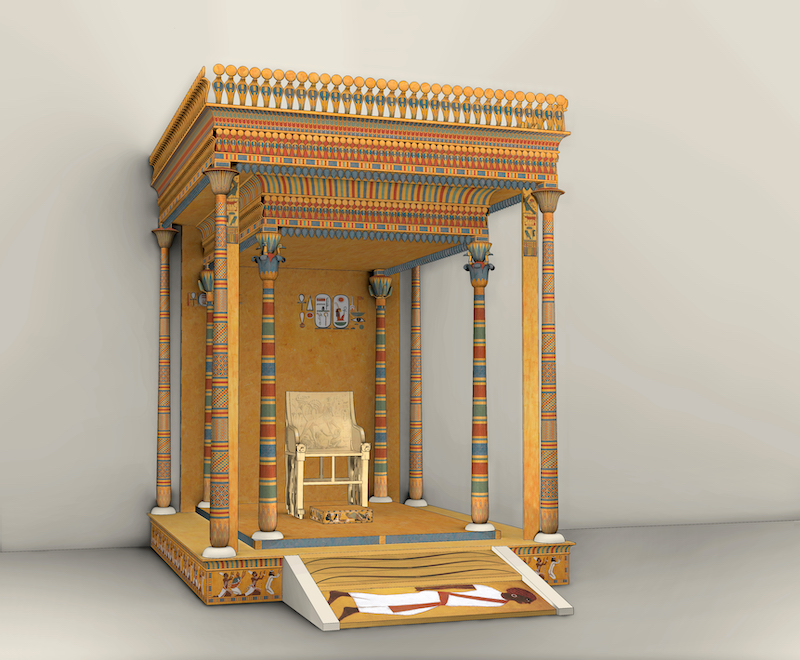Virtual Malqata
The royal palaces of Ancient Egypt were so intimately connected to the government of the country that their name, the pr-aa, eventually became synonymous with the king, the pharaoh. Despite their importance, however, only a few palaces have been excavated. The best-preserved of all is in southwestern Thebes, the palace complex at Malqata of Amenhotep III. Amenhotep the Magnificent, as he is known, ruled from 1386-1353 BCE and was Egypt’s greatest builder. The palace itself was positioned on the desert edge of cultivation, on high ground overlooking the surrounding administrative buildings and residences. Nearby was the huge artificial harbor, the Birket Habu, where the earth extracted in its creation was landscaped into a series of regular mounds.
It is not surprising that Amenhotep’s palace was sumptuously decorated with beautiful paintings on walls, floors and ceilings. Excavations of this site began with Daressy at the end of the 19th century. Yet, despite their importance, these glorious paintings have been poorly documented and preserved.
Reconstruction of the royal baldachin of Amenhotep III
By the 21st century, Raymond Johnson, director of Chicago House Luxor, and Hoeliel Ghali, chief inspector at Luxor, worried about the survival of this important site. They approached Peter Lacovara, who proposed The Metropolitan Museum of Art revisit the site to protect and restore the palace and surrounding structures and to publish the records of the Met’s excavations there a century ago. A lot of work remains to be completed, particularly preserving the precious paintings. Thanks to grants from the American Research Center in Egypt’s Antiquities Endowment Fund, members of the Ancient Egyptian Heritage and Archaeology Fund have begun to assess the painted decoration enough to digitally reconstruct what the palace may have looked like in its royal glory.
In 2016, Franck Monnier took on this mission with the aid of Paul François. They used state-of-the-art digital reconstruction technologies and 3-D software to create a platform to test various viewpoints of the site and to validate architectural and decoration presumptions. The resulting digital imagery also enabled researchers to produce different renderings, such as day and night views. While this virtual animation brings the site back to life, this computing power must not downplay the importance of the fundamentals of archaeological reconstruction. Documentary research and the cross-referencing of archeological data remain the foundation of such an undertaking.
The Malqata digital project was complex and multifaceted. It included a collaboration with Paul François that produced a scientific and virtual reconstruction of the columned hall. Franck Monnier then focused on 3-D colored drawings of an aerial view of the palace complex and a three-quarters view of the royal canopy with its throne, combining 3-D with image processing software. The process also included gathering all existing documentation related to this part of the palace. Archaeological surveys were first undertaken by Robb de Peyster Tytus (1901-02) and then the Metropolitan Expedition in the early 20th century provided a precise layout of the walls, as well as the location of doors to adjacent rooms. The result was a three-dimensional reconstruction of the columned hall and the throne room to which it leads. The team also raised the roof of the central aisle to display light-giving clerestories. Fragments documented in the 1980s by a team from Waseda University allowed the entire decoration of the roofs of the side spans to be reconstructed.
While the ceiling decoration was well-preserved, the decorative themes on the side walls are undetermined. The houses and palaces of Tell el Amarna indicate they complemented the surrounding environment, which included gardens and the riverbank, and that they celebrated activities such as dancing, music and banqueting. Paintings from the tomb of Nebamun, contemporary of the reign, offered the digital reconstruction team typical scenes that were tested on a single lower register. Tytus claimed the king himself was represented on the south wall, sitting on his throne and surrounded by captives. Unfortunately, this scene has disappeared, so the virtual walls were left almost blank.
On the floor, fragments depicted reed and papyrus thickets in which various bird species, like ducks, flourished. In the palaces of Tell el Amarna, foreign prisoners were shown with their arms tied behind their backs, lined up before the king’s raised throne. On the throne, a richly decorated baldachin (canopy) would have been depicted. This was reconstructed digitally from a number of tomb paintings showing Amenhotep III enthroned, especially the colored scene in tomb TT226 reproduced by Nina de Garis Davies. The virtual reconstruction used the available space of the brick platform to interpret contemporary representations of a royal nested canopy. Rendering this richly decorated piece of furniture posed many problems, including the complexity of a “floral bouquet” from a lily bud, duck heads and a lotus bud.
This research and digital modeling at Malqata documented one of Egypt’s most majestic and well-documented Pharaonic palaces and, eventually, led to the first scientific reconstruction of a royal decorated baldachin.
Recommended Reading
Peter Lacovara and Alexandra Winkles, “Malqata-The Painted Palace,” in Johannes Becker, Johannes Jungfleisch & Constance von Rüden, eds, Tracing Technoscapes. The Production of Bronze Age Wall Paintings in the Eastern Mediterranean. Leiden: Sidestone Press, 2018. pp. 149-172.
Franck Monnier, Vocabulaire D’Architecture Égyptienne, Brussels: Editions Safran, 2013.
